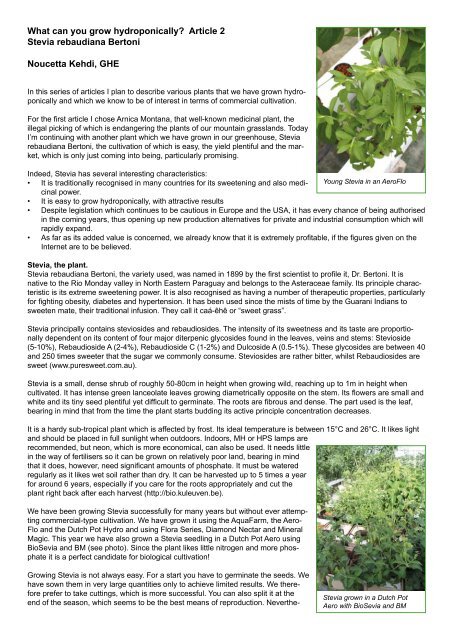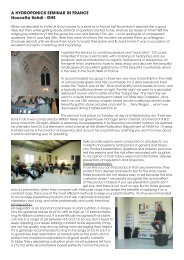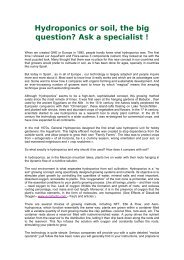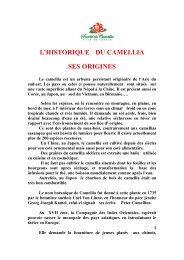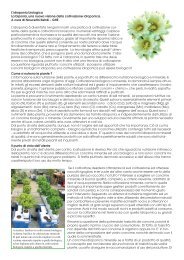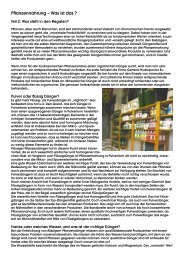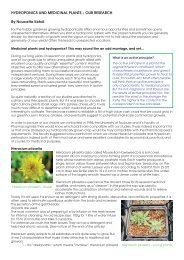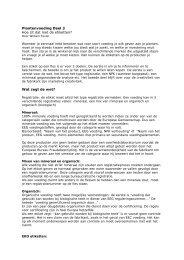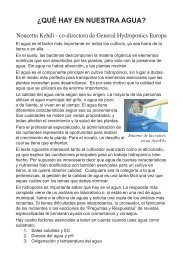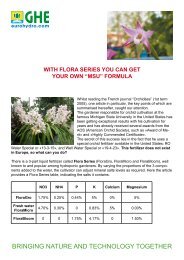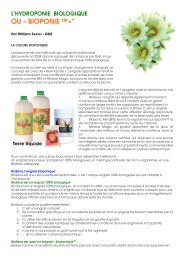What can you grow hydroponically? Article 2 Stevia rebaudiana ...
What can you grow hydroponically? Article 2 Stevia rebaudiana ...
What can you grow hydroponically? Article 2 Stevia rebaudiana ...
Create successful ePaper yourself
Turn your PDF publications into a flip-book with our unique Google optimized e-Paper software.
<strong>What</strong> <strong>can</strong> <strong>you</strong> <strong>grow</strong> <strong>hydroponically</strong>? <strong>Article</strong> 2<br />
<strong>Stevia</strong> <strong>rebaudiana</strong> Bertoni<br />
Noucetta Kehdi, GHE<br />
In this series of articles I plan to describe various plants that we have <strong>grow</strong>n <strong>hydroponically</strong><br />
and which we know to be of interest in terms of commercial cultivation.<br />
For the first article I chose Arnica Montana, that well-known medicinal plant, the<br />
illegal picking of which is endangering the plants of our mountain grasslands. Today<br />
I’m continuing with another plant which we have <strong>grow</strong>n in our greenhouse, <strong>Stevia</strong><br />
<strong>rebaudiana</strong> Bertoni, the cultivation of which is easy, the yield plentiful and the market,<br />
which is only just coming into being, particularly promising.<br />
Indeed, <strong>Stevia</strong> has several interesting characteristics:<br />
• It is traditionally recognised in many countries for its sweetening and also medicinal<br />
power.<br />
Young <strong>Stevia</strong> in an AeroFlo<br />
• It is easy to <strong>grow</strong> <strong>hydroponically</strong>, with attractive results<br />
• Despite legislation which continues to be cautious in Europe and the USA, it has every chance of being authorised<br />
in the coming years, thus opening up new production alternatives for private and industrial consumption which will<br />
rapidly expand.<br />
• As far as its added value is concerned, we already know that it is extremely profitable, if the figures given on the<br />
Internet are to be believed.<br />
<strong>Stevia</strong>, the plant.<br />
<strong>Stevia</strong> <strong>rebaudiana</strong> Bertoni, the variety used, was named in 1899 by the first scientist to profile it, Dr. Bertoni. It is<br />
native to the Rio Monday valley in North Eastern Paraguay and belongs to the Asteraceae family. Its principle characteristic<br />
is its extreme sweetening power. It is also recognised as having a number of therapeutic properties, particularly<br />
for fighting obesity, diabetes and hypertension. It has been used since the mists of time by the Guarani Indians to<br />
sweeten mate, their traditional infusion. They call it caá-êhê or “sweet grass”.<br />
<strong>Stevia</strong> principally contains steviosides and rebaudiosides. The intensity of its sweetness and its taste are proportionally<br />
dependent on its content of four major diterpenic glycosides found in the leaves, veins and stems: Stevioside<br />
(5-10%), Rebaudioside A (2-4%), Rebaudioside C (1-2%) and Dulcoside A (0.5-1%). These glycosides are between 40<br />
and 250 times sweeter that the sugar we commonly consume. Steviosides are rather bitter, whilst Rebaudiosides are<br />
sweet (www.puresweet.com.au).<br />
<strong>Stevia</strong> is a small, dense shrub of roughly 50-80cm in height when <strong>grow</strong>ing wild, reaching up to 1m in height when<br />
cultivated. It has intense green lanceolate leaves <strong>grow</strong>ing diametrically opposite on the stem. Its flowers are small and<br />
white and its tiny seed plentiful yet difficult to germinate. The roots are fibrous and dense. The part used is the leaf,<br />
bearing in mind that from the time the plant starts budding its active principle concentration decreases.<br />
It is a hardy sub-tropical plant which is affected by frost. Its ideal temperature is between 15°C and 26°C. It likes light<br />
and should be placed in full sunlight when outdoors. Indoors, MH or HPS lamps are<br />
recommended, but neon, which is more economical, <strong>can</strong> also be used. It needs little<br />
in the way of fertilisers so it <strong>can</strong> be <strong>grow</strong>n on relatively poor land, bearing in mind<br />
that it does, however, need signifi<strong>can</strong>t amounts of phosphate. It must be watered<br />
regularly as it likes wet soil rather than dry. It <strong>can</strong> be harvested up to 5 times a year<br />
for around 6 years, especially if <strong>you</strong> care for the roots appropriately and cut the<br />
plant right back after each harvest (http://bio.kuleuven.be).<br />
We have been <strong>grow</strong>ing <strong>Stevia</strong> successfully for many years but without ever attempting<br />
commercial-type cultivation. We have <strong>grow</strong>n it using the AquaFarm, the Aero-<br />
Flo and the Dutch Pot Hydro and using Flora Series, Diamond Nectar and Mineral<br />
Magic. This year we have also <strong>grow</strong>n a <strong>Stevia</strong> seedling in a Dutch Pot Aero using<br />
BioSevia and BM (see photo). Since the plant likes little nitrogen and more phosphate<br />
it is a perfect <strong>can</strong>didate for biological cultivation!<br />
Growing <strong>Stevia</strong> is not always easy. For a start <strong>you</strong> have to germinate the seeds. We<br />
have sown them in very large quantities only to achieve limited results. We therefore<br />
prefer to take cuttings, which is more successful. You <strong>can</strong> also split it at the<br />
end of the season, which seems to be the best means of reproduction. Neverthe-<br />
<strong>Stevia</strong> <strong>grow</strong>n in a Dutch Pot<br />
Aero with BioSevia and BM
less, our plants remain rather small in relation to the metre-high cultivated<br />
shrubs referred to in the literature. Ours seldom exceed 50-70cm. It must<br />
be said that, as commercial cultivation was not our aim, we did not force<br />
the plants but rather were happy to develop shrubs that were just large<br />
enough for personal consumption. Our plants are, however, beautiful,<br />
large-leafed, deep green in colour and extremely lush.<br />
<strong>Stevia</strong>’s known enemies are primarily aphids and slugs. The literature<br />
talks of Septoriosis, a fungal disease which is believed to be the cause of<br />
signifi<strong>can</strong>t crop loss but which, fortunately, we have not yet experienced<br />
(gireaud.net/stevia.htm). Our plants have been affected by whitefly, those<br />
little white flies which <strong>can</strong> be particularly destructive. We fought them using<br />
Macrolophus caliginosus, one of their natural predators.<br />
It is the old leaves which are the richest in active principles. The harvest must take place before budding begins. You<br />
must therefore cut the plant back before August/September, when it starts to bud. It <strong>can</strong> be cut back often in order to<br />
preserve it over time and thus get several harvests in a year. Fresh leaves <strong>can</strong> be used. They have a rather strong<br />
taste, similar to that of liquorice. But it is generally used in its dried powder form. It is also converted in some countries<br />
and comes in the forms of both a white crystalline powder and an extremely concentrated liquid extract. The leaves<br />
are dried in the shade, in a ventilated space and below 40°C, in order to preserve them for as long as possible. In<br />
order to prepare it for consumption the well-dried, crisp leaves must be crushed in a coffee mill. (www.aromatiques.<br />
com/fichesculture.stevia.html). This leaves <strong>you</strong> with a more or less finely ground green powder that <strong>can</strong> be added to<br />
coffee and infusions and that <strong>can</strong> also be used in cooking since it remains stable when faced with pH variations and<br />
high temperatures.<br />
If <strong>you</strong> live in a country where it is forbidden to consume it, <strong>you</strong> should not do so. But anywhere else, in a private capacity,<br />
there is nothing to prevent <strong>you</strong> from <strong>grow</strong>ing <strong>you</strong>r own <strong>Stevia</strong> plant at home, on <strong>you</strong>r balcony or indoors. The<br />
result will be <strong>you</strong>r own plant, the quality of which will be in <strong>you</strong>r control, and which <strong>you</strong> <strong>can</strong> use to sweeten <strong>you</strong>r infusions.<br />
In order to avoid consuming too much of it, it is recommended that <strong>you</strong> start with very small doses and adapt<br />
it to individual tastes. However, care should be taken when using it for therapeutic<br />
purposes; it is always best to consult a doctor before beginning any self-treatment as<br />
plants <strong>can</strong> also be harmful.<br />
<strong>Stevia</strong> <strong>grow</strong>n in an AeroFlo with Flora Series,<br />
Diamond Nectar and Mineral Magic<br />
<strong>Stevia</strong> flowers<br />
Is <strong>Stevia</strong> dangerous, then? Why should this interest us?<br />
<strong>Stevia</strong> is natural product which contains 0 calories, especially when consumed in the<br />
form of dried leaves. It has become increasingly successful over the past few years,<br />
primarily due to its sweetening power but also because of its therapeutic properties.<br />
<strong>Stevia</strong> does indeed seem harmless and <strong>can</strong> be an advantageous replacement for sugar<br />
and especially its substitutes such as aspartames, saccharins and cyclamates, the<br />
extreme dangers of which are now recognised. It also seems that it <strong>can</strong> be used for<br />
hypertension, digestive problems, obesity and oral hygiene and that it is of particular<br />
interest to diabetics, who <strong>can</strong> safely consume it.<br />
The tribes of South America (Brazil, Paraguay and Uruguay) have been<br />
using <strong>Stevia</strong> for centuries for its sweetening and therapeutic powers with<br />
no apparent problems thus far. There is much scientific research today,<br />
particularly in Australia and Thailand, which does not show the plant<br />
to involve any danger. Nevertheless it remains a “risk» for the health<br />
services in some countries, especially in the West. It is a very controversial<br />
plant in Europe and the United States especially, where they insist<br />
on its potentially dangerous side and where further in-depth studies are<br />
awaited. We therefore have a European law, document 300DO196 dated<br />
22nd February 2000, relating to the refusal of marketing authorisation for<br />
«<strong>Stevia</strong> <strong>rebaudiana</strong> Bertoni, in plant and dried leaf form, as a new foodstuff<br />
or food ingredient in accordance with the European Parliament’s<br />
regulation CE N° 258/97» (gireaud.net/stevia.htm). However, it <strong>can</strong> be<br />
found in various forms to be consumed on the Internet and <strong>you</strong> <strong>can</strong> buy<br />
the fresh plant from many nurseries throughout Europe.<br />
Some explain its prohibition by the fact that the sugar industry (beet and <strong>can</strong>e), which is particularly dynamic in our<br />
countries, does not wish to be superceded by <strong>Stevia</strong>.The economic interests are indeed immense.<br />
In 1970, the Japanese government banned the use of synthetic sweeteners and allowed the marketing of natural<br />
steviosides. The Japanese have been using <strong>Stevia</strong> in extract and powder form for nearly 40 years and have thus<br />
far found no drawbacks in its consumption. It represents 40% of the sweetener market in Japan and Korea and an
<strong>Stevia</strong> <strong>grow</strong>n in a Dutch Pot<br />
Hydro with Flora Series<br />
increasing number of countries, such as China, Taiwan, Thailand and Malaysia, are<br />
consuming it. Large-scale production of <strong>Stevia</strong> is already underway in Argentina,<br />
Brazil, Uruguay, Central America, the United States, Canada, England, Lebanon<br />
and Israel among other countries. (fr.wikipedia.org). China and Brazil alone are<br />
responsible for 90% of the global production.<br />
Harvests vary between 1,500kg and 3,000kg per hectare. For <strong>Stevia</strong> extract alone<br />
the market is estimated at 1.5 billion kilos, converted from 12 million kilos of leaves!<br />
(www.puresweet.com.au)<br />
You <strong>can</strong> also see the multitude of offers of <strong>Stevia</strong> in all its forms on the Internet and<br />
the plant form already has attractive outlets wherever its sale is authorised.<br />
All this goes to show that this market<br />
has huge potential. A hydroponic<br />
greenhouse produces around a further<br />
30% of harvests. When used correctly,<br />
fertilisers <strong>can</strong> guarantee a high quality<br />
plant which is rich in active principles.<br />
We have the know-how to do this.<br />
In 2000, the Department of Pharmacognosy in Toulouse analysed and<br />
compared crops from our greenhouse with outstanding results. (www.<br />
eurohydro.com/pdf/articles/fr_medical.pdf). The commercial farming of<br />
<strong>Stevia</strong> <strong>can</strong> thus be viewed as a new alternative to traditional cultivation,<br />
which would enable a new income to be generated in a society which<br />
needs all its resources to create solid and beneficial wealth.<br />
For more info, don’t hesittate to contact us!<br />
End of flowering: <strong>Stevia</strong> produces a huge<br />
amount of seeds.


